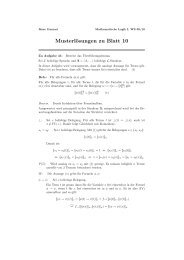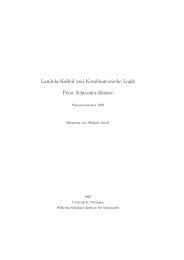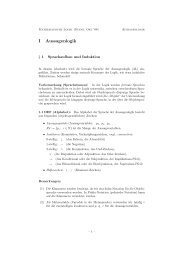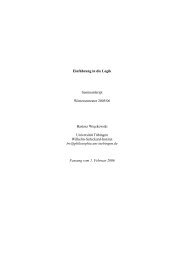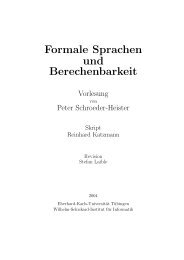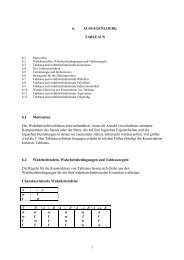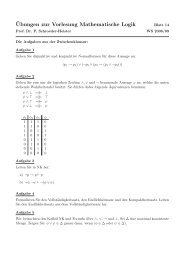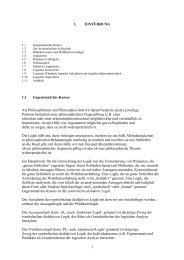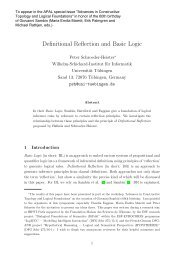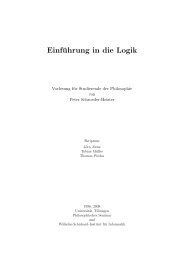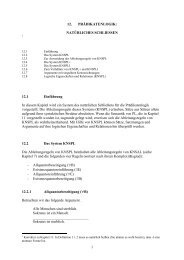Constructive semantics and the validity of Peirce's law
Constructive semantics and the validity of Peirce's law
Constructive semantics and the validity of Peirce's law
You also want an ePaper? Increase the reach of your titles
YUMPU automatically turns print PDFs into web optimized ePapers that Google loves.
monotonicity (B ′ extends B) k ′ also establishes �B ′(p ⊃ q) ⊃ p. Therefore, �B ′ p<br />
by construction k ′ (k ′′ ). As p is basic, we have ⊢B ′ p according to clause (1′ ) (this<br />
corresponds to Prawitz’s clause (i)), that is, <strong>the</strong> construction k ′ (k ′′ ) is a derivation <strong>of</strong><br />
p in basis B ′ .<br />
There are two cases: First, if <strong>the</strong> derivation k ′ (k ′′ ) does not use <strong>the</strong> basic rule p<br />
q ,<br />
<strong>the</strong>n <strong>the</strong> derivation is already a derivation <strong>of</strong> p in B. Second, if <strong>the</strong> derivation k ′ (k ′′ )<br />
uses it, <strong>the</strong>n <strong>the</strong>re is a topmost occurrence <strong>of</strong> this rule, <strong>and</strong> <strong>the</strong> subderivation <strong>of</strong> its<br />
premiss is already a derivation <strong>of</strong> p in B. In both cases ⊢B p by a derivation k∗ <strong>and</strong>,<br />
consequently, �B p by construction k∗ .<br />
The construction k establishing p in B is <strong>the</strong> following procedure: We first apply<br />
k ′ to a fixed construction k ′′ . This construction k ′ (k ′′ ) is a derivation using only basic<br />
rules <strong>of</strong> B ′ . We <strong>the</strong>n extract construction k∗ from construction k ′ (k ′′ ) by inspection.<br />
We start with <strong>the</strong> topmost application <strong>of</strong> a basic rule <strong>and</strong> do a downward search<br />
until we find a conclusion p. This is bound to occur, since <strong>the</strong> derivation k ′ (k ′′ ) is a<br />
construction <strong>of</strong> p. �<br />
Moreover, by using (⊃I) <strong>and</strong> (⊃E), which are supposed to be validated by <strong>the</strong><br />
<strong>semantics</strong>, Peirce’s <strong>law</strong> ((ϕ ⊃ �) ⊃ ϕ) ⊃ ϕ can by induction be shown to be valid for<br />
atoms ϕ <strong>and</strong> any � in <strong>the</strong> fragment {⊃}. And <strong>the</strong> <strong>validity</strong> <strong>of</strong> Peirce’s <strong>law</strong> for any<br />
ϕ <strong>and</strong> � can <strong>the</strong>n be obtained by induction too, taking into account <strong>the</strong> remarks at<br />
<strong>the</strong> end <strong>of</strong> section 2. We take this result as implying that, from a constructivist point<br />
<strong>of</strong> view, <strong>the</strong> use <strong>of</strong> bases containing only production rules (i.e., basic rules without<br />
<strong>the</strong> discharging <strong>of</strong> assumptions) has to be revised. O<strong>the</strong>rwise a non-constructive<br />
principle would be validated, rendering <strong>the</strong> fragment {⊃} <strong>of</strong> NM <strong>and</strong> NI incomplete<br />
with respect to <strong>the</strong> <strong>semantics</strong>.<br />
Of course, this argument is not sufficient for <strong>the</strong> positive claim that <strong>the</strong> constructive<br />
<strong>semantics</strong> obtained by permitting atomic bases with discharge <strong>of</strong> assumptions<br />
is appropriate for intuitionistic logic. There may be o<strong>the</strong>r defects in this kind <strong>of</strong><br />
pro<strong>of</strong>-<strong>the</strong>oretic <strong>semantics</strong>, in particular when logical constants beyond implication<br />
are concerned.<br />
5 Funding<br />
This work was supported by Coordenação de Aperfeiçoamento de Pessoal de Nível<br />
Superior (CAPES) <strong>and</strong> Deutscher Akademischer Austauschdienst (DAAD), grant<br />
[1110-11-0 CAPES/DAAD to W.d.C.S.], by Agence National de la Recherche (ANR)<br />
<strong>and</strong> Deutsche Forschungsgemeinschaft (DFG) within <strong>the</strong> French-German ANR-<br />
DFG project “Hypo<strong>the</strong>tical Reasoning”, grant [DFG Schr 275/16-1/2 to T.P. <strong>and</strong><br />
P.S.-H.]; <strong>and</strong> by a German-Brazilian exchange grant [444 BRA-113/66/0-1 to T.P.<br />
<strong>and</strong> P.S.-H.].<br />
References<br />
[1] Dummett, M. (1991). The Logical Basis <strong>of</strong> Metaphysics. London: Duckworth.<br />
10



